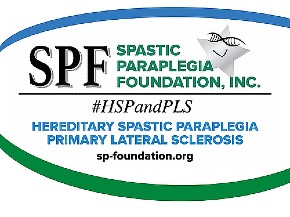A Comparison of Hereditary Spastic Paraparesis (HSP) and Primary Lateral Sclerosis (PLS)
Reviewed by John K. Fink, M.D., Department of Neurology , University of Michigan, and Geriatric Research Education and Clinical Center, AAVAMC, Ann Arbor, Michigan; Medical Advisor, Spastic Paraplegia Foundation.
| Hereditary Spastic Paraplegia | Primary Lateral Sclerosis | |
|---|---|---|
| What is it? | A group of degenerative, neurological disorders chiefly affecting upper motor neurons and principally causing progressive spastic weakness of the legs. Also known as familial spastic paraplegia or paraparesis (FSP) and Strumpell-Lorrain syndrome. | A group of degenerative, neurological disorders chiefly affecting upper motor neurons and causing progressive spastic weakness of the legs as well as the arms and bulbar muscles. |
| Population Frequency | Estimated to be 10,000 to 20,000 individuals in the U.S. Frequency may be higher because HSP is frequently misdiagnosed or undiagnosed. | Frequency is estimated to be 1000 to 2000. Estimated at 300-500 individuals in the U.S. have PLS. |
| Predominant Features | Insidious, progressive spasticity and weakness of the legs that often gets severe, requiring assistive devices. There may be difficulty with balance and muscle cramps in the legs. | Insidiously progressive spasticity and weakness of the legs that often gets severe, requiring assistive devices. Gradually, weakness and decreased dexterity of the arms and hands occurs, followed by difficulty speaking and swallowing. |
| Secondary Features | Urinary urgency and frequency are common and high arched feet are often present. Rare types can present speech problems, ataxia, intellectual disability, dementia, visual or hearing dysfunctions, extrapyramidal dysfunctions, or ichthyosis. | Urinary urgency and frequency are common. |
| What causes it? | HSP is hereditary, with more than 90 genetic types. There are dominant, recessive, and X-linked genetic types of HSP. | With very rare exception, PLS does not occur in families as an inherited condition. One rare form of PLS begins in childhood and is inherited as a recessive condition. |
| What is going wrong? | Nerves located in the brain motor cortex control voluntary movement. They deliver signals through their processes (“axons”) to lower motor neurons located in the spinal cord. These spinal motor neurons transmit their impulses to the muscles. In HSP there is degeneration of the cell processes (“axons”) of the brain motor nerves. As a result, nerve impulses do not adequately reach the spinal motor neuron. This causes spasticity (increased muscle tone/stiffness) and weakness. These symptoms increase over time as the nerve degeneration progresses. | Nerves located in the brain motor cortex control voluntary movement. They deliver signals through their processes (“axons”) to lower motor neurons located in the spinal cord. These spinal motor neurons transmit their impulses to the muscles. In PLS there is degeneration of the cell processes (“axons”) of the brain motor nerves. As a result, nerve impulses do not adequately reach the spinal motor neuron. This causes spasticity (increased muscle tone/stiffness) and weakness. These symptoms increase over time as the nerve degeneration progresses. |
| How is it diagnosed? | For many individuals, HSP is a clinical diagnosis made through exclusion of other possibilities and examining family history. Absence of documented family history cannot rule out HSP. It is estimated some 30% of individuals with HSP do not have documented family history. Gene testing is increasingly available. At present, gene testing can confirm the diagnosis of HSP in approximately 75% of subjects who have HSP as a dominantly inherited condition. Early stages of HSP can mimic PLS or ALS. In the absence of family history, neurologists watch for involvement of muscles in the arms, speech or swallowing (which might suggest PLS or ALS); and significant muscle atrophy (which might indicate ALS). Electromyography (EMG) and nerve conduction studies, MRI scans of the brain and spinal cord, and laboratory studies are helpful in distinguishing HSP from other disorders. | PLS is a clinical diagnosis made through exclusion of other possibilities and examining family history. Absence of documented family history cannot rule out HSP as a possible diagnosis. Early stages of PLS, when symptoms are confined to leg weakness and spasticity can mimic HSP or ALS. Neurologists watch for involvement of muscles in the arms, speech or swallowing (which would suggest PLS and not HSP); as well as evidence of significant muscle atrophy (which might indicate ALS). Electromyography (EMG) and nerve conduction studies, MRI scans of the brain and spinal cord, and laboratory studies are helpful in distinguishing PLS from other disorders. |
| Age of onset | Symptoms can begin at any age from childhood through late adulthood. Most patients experience onset of symptoms in the second – fourth decades of life. | The reported age of onset ranges from 35-66 years with a median of 50.5 years. A rare, child-onset form has been reported. |
| What is the prognosis? | It affects the quality of life. Difficulty walking usually gets slowly worse, often requiring canes, walkers, or wheelchairs. However, some individuals with childhood-onset of symptoms experience very little worsening. | It affects the quality of life. Difficulty walking usually gets slowly worse, often requiring canes, walkers, or wheelchairs. Speech and swallowing difficulty and weakness and decreased dexterity of the arms may become severe. |
| What is the treatment? | There is no treatment to prevent, retard or reverse the degenerative process. Treatment is focused on symptom relief (medications for spasticity), physical therapy and exercise, assistive devices and supportive therapy. | There is no treatment to prevent, retard or reverse the degenerative process. Treatment is focused on symptom relief (medications for spasticity), physical therapy and exercise, assistive devices, speech therapy and supportive therapy. |
| What research is being done? | HSP research is accelerating. Important advances have been made. More than 50 HSP genes have been discovered and scientists are searching for more. Animal models of HSP have been created in which potential treatments can be tested. | There have been few researchers working on PLS. Fortunately, there are more today and research is accelerating. PLS research is currently done in conjunction with research on related disorders. A gene for a very rare, familial form of PLS has been identified. Scientists are working to understand this gene and how mutations lead to upper nerve degeneration. There is also research being conducted regarding spasticity treatments and understanding neurological functioning. It is hopeful that treatments or cures discovered for other neurological conditions may be applicable to PLS. |
Sources: • Fink, JK. Hereditary Spastic Paraplegia. Emery and Rimoins Principles and Practice of Medical Genetics, Fourth Edition, 2001. • Primary Lateral Sclerosis, Carmel Armon, M.D., eMedicine Journal, January 30 2002, Volume 3, Number 1 • Hereditary Spastic Paraparesis, Nam-Jong Paik, MD, PhD, eMedicine Journal, January 15 2002, Volume 3, Number 1 • Progressive Spastic Paraparesis: Hereditary Spastic Paraplegia and Its Relation to Primary and Amyotrophic Lateral Sclerosis, John K. Fink M.D., Semin Neurol 2001 Jun; 21(2):199-207 • Atypical Motor Neuron Disease and Related Motor Syndromes, Ashok Verma M.D. D.M., Walter G. Bradley D.M. F.R. C.P., Semin Neurol 2001 Jun; 21(2):177-87
Our Impact since our inception...
-
Dollars Raised
Over 12,000,000 dollars for research!










